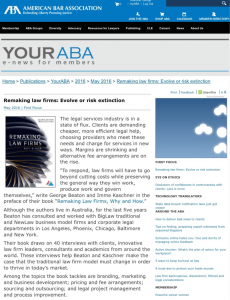Q&A on Remaking Law Firms
In May, Priscilla Totten published this Q&A on Remaking Law Firms in the American Bar Association’s e-News. The article enjoyed a record number of hits, and is reproduced here with permission.
 With the legal services industry in a state of flux, clients are choosing providers who meet their needs and charge for services in new ways.
With the legal services industry in a state of flux, clients are choosing providers who meet their needs and charge for services in new ways.
“To respond, law firms will have to go beyond cutting costs while preserving the general way they win work, produce work and govern themselves,” write George Beaton and Imme Kaschner in the preface of “Remaking Law Firms, Why and How.”
Although the authors live in Australia, for the last five years Beaton has consulted and worked with BigLaw traditional and NewLaw business model firms and corporate legal departments in Los Angeles, Phoenix, Chicago, Baltimore and New York.
The book draws on 40 interviews with clients, innovative law firm leaders, consultants and academics from around the world.
Among the topics it tackles are analyzing your firm’s readiness for change; branding, marketing and business development; pricing and fee arrangements; sourcing and outsourcing; and legal project management and process improvement.
YourABA asked the authors for some details
You note that corporate clients are relying more on their in-house counsel due to cost pressures on them. What services are still largely outsourced and what kind of business is being taken in house? And, given this trend, should law firms place a greater emphasis on targeting work at firms without in-house legal departments?
Outsourcing of services varies by corporation. Some are still in the mode of outsourcing most of their work, irrespective of volume and complexity, while others are aggressively bringing ever more in-house.
The trend is increasingly in-house. The types of work going in-house (or being supervised by in-house people and undertaken by LPOs like Elevate and Pangea3, or managed legal services like Axiom provides) are more at the commoditized end of business law, for instance, real property (leases) and financial services (securities).
But the company and mission-critical work – major litigation, M&A, IPOs – still goes to outside counsel.
Our book devotes a section to the opportunity companies with no in-house lawyers offer law firms. Research from the UK suggests traditional law firms are meeting only 20 percent of the legal needs of these smaller businesses. The balance is going to accountants and consultants or not being addressed at all.
At the same time we are seeing some inspiring examples of traditional law firms’ offerings for these types of clients, such as Cooley Go, which offer cradle-to-grave services for start-ups and other entrepreneurs.
Fee discounts
You’ve noted that law firms have largely relied on discounts in reaction to increasing demand from clients for lower costs. What’s the danger of that trend?
Discounting may win a firm the next piece of work, but it creates an expectation that price has been re-set lower for the next and the next pieces of work. Thus, discounting is a race to the bottom.
Once a firm starts using discounting to win work and hold clients, the firm has stepped onto a slippery slope. To maintain profits on a per-partner basis, these firms first cut ‘non-essential’ costs like support staff and investments in marketing and information technology. As these reach the irreducible minimum, the firms start reducing the number of equity partners and/or the average number of points per equity partner.
Our book has a major case study showing that these tactics are approaching the point of end-game; there’s little ‘fat’ left to cut and no more equity to strip out without irreparable harm to the fabric and culture of the firm. Once this stage is reached, a firm often enters into merger negotiations; these are in effect ‘rescue mergers’ as Edwin Reeser, a contributor to Remaking Law Firms, calls them.
Obstacles to change
Yet – among firms with more than 250 partners, only 53 percent have changed their approach to pricing. What are the obstacles to change and how can firms overcome them?
There are two types of obstacles:
Cultural and false hope. The partners of many firms still believe that we’re in a prolonged recession and that the ‘good old days’ will eventually return. So we don’t have to change very much, just batten down the hatches and wait. Sadly, for these firms and their failure to understand the fact that the change is structural (albeit accentuated by the 2008 financial crisis) and that we are now in – and will remain in – a buyers’ market, means they will suffer declines in profitability. A section in Remaking Law Firms suggests this decline may be as much as halving of the profit per point of equity.
Clients. Our empirical research among clients of BigLaw firms shows that as much as half of corporate clients still rely on discounted hourly rates as the basis for negotiating outside counsel fees. These corporate legal departments are almost all led by former BigLaw firm partners who have only known hourly rates and are therefore most comfortable with them. The ACC Corporate Challenge is starting to change this.
For firms moving beyond the billable hour, what are some of the elements of a successful alternative fee arrangement (AFA)?
The most important is to flex and offer clients a choice in how a firm’s services are priced. Some clients may prefer traditional time-based charging, while others want absolute certainty, including in litigation.
Where the firm is taking the commercial risk, as in offering a fixed price, then the firm must have a high degree of certainty that it can ‘make’ the service at a profit. This is where law practice management is important: Is the matter scoped and resourced in a manner that satisfies the client’s budget, timeline and quality needs and, at the same time, is profitable for the firm? Eventually, if a firm meets the client’s needs on sub-economic terms or charges too much, the relationship will sour and nobody wins.
Cost consciousness is far more important than price
I was surprised to learn from your book that a lawyer’s “cost consciousness” is far more important to clients than the actual price of services. Could you explain that and share how firms can foster an impression of cost consciousness?
Value is in the eye of the beholder. In all professional services, value is a function of how clients perceive and link the following components:
- What I get (the benefits you deliver to me). Examples of benefits are ‘peace of mind,’ ‘saving me money,’ and ‘reducing our risk to acceptable levels.’ Most attorneys do not think of benefits and rather describe the features of what they do for clients.
- What I pay (the price or fee). Our and others’ research shows that for a ‘product’ like legal services, price plays a heuristic role. ‘Heuristic’ means a signal for quality. Too cheap, and the product is suspect. Too dear, and it’s not worth paying so much. For clients’ there’s a ‘zone of tolerance’ between being cheap and suspect and expensive and a rip-off. In other words, like Goldilocks’ porridge, a law firm must find the price that’s just right – the upper end, but inside the zone of tolerance. Blanket one-rate-fits-all pricing doesn’t work any more.
- How I know what you, the attorney, are spending my money on (cost consciousness). Given the intricacies of the trade-offs clients have to make and the information asymmetry between client and attorney, it’s no wonder that cost consciousness is so important. But, like many research-based findings, too many attorneys and their firms still don’t get it. It takes years for ideas like this to disseminate and change the way attorneys and their clients perceive value, and for attorneys to learn to change the conversation with clients from price (fees) to perceived value.
Cost-conscious behavior is an attitude and skill. It requires high-level interpersonal communication to explain, and confidence on the part of the attorney that their services will deliver benefits to the client. Too many attorneys lack these skills and don’t approach their services through the lens of benefits to clients.
Outsourcing
To gain flexibility in today’s uncertain market, many firms are outsourcing. What are some ways that firms can best ensure the quality of the work?
Broadly speaking, outsourcing of legal services comes in two forms, namely to a firm’s own captive, and third party provider/s.
The former offers the easier way of assuring quality, especially if, as some UK firms have done, all the lawyers in the captive are alumni of the firm.
QA with third parties is harder, but experience shows that market mechanisms are operating and the better-quality third parties are flourishing.
In both situations firms need to develop new capabilities in measuring and managing the supply chain and tracking client satisfaction in real time so that immediate feedback loops are in-built and effective. Few firms have started on this journey.
Change to remain competitive
You suggest many changes that law firms should make to remain competitive. Given how risk-averse lawyers tend to be, what are some ways that law firms can create a successful culture of change among their ranks?
Key ingredients in successful, sustained change include visionary, stable leadership that is trusted by the partners and a change agenda that is grounded in reality and adequately resourced.
As one managing partner we cite in the book says, “If a partner says to me ‘All we need is a nip and a tuck and we’re done,’ then I know I have failed to fully communicate the message: ‘Change is a permanent state and if you feel comfortable with the way you are practicing and leading your team, then I failed to get through to you.’”
Key elements in change are incentive to change and an appreciation of the consequences of not changing. The partner compensation system is central to this. What behaviors and outcomes are recognized and rewarded? Old-style compensation based purely on rainmaking and fees generated is an anathema in the new world of remade law firms.
Author
 Priscilla Totten is Manager, Communications at American Bar Association.
Priscilla Totten is Manager, Communications at American Bar Association.
The authors thank Priscilla for her support in preparing our answers to her insightful questions.


Leave a Reply